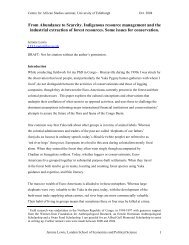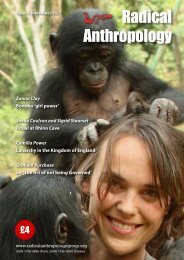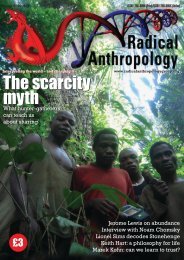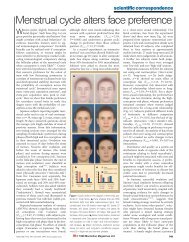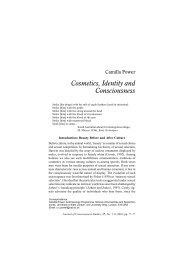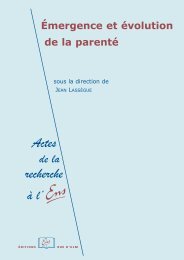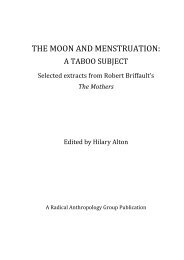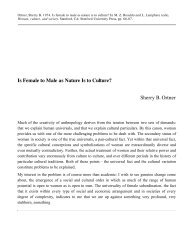Language and life history: A new perspective on the development ...
Language and life history: A new perspective on the development ...
Language and life history: A new perspective on the development ...
- No tags were found...
You also want an ePaper? Increase the reach of your titles
YUMPU automatically turns print PDFs into web optimized ePapers that Google loves.
Commentary/Locke & Bogin: <str<strong>on</strong>g>Language</str<strong>on</strong>g> <str<strong>on</strong>g>and</str<strong>on</strong>g> <str<strong>on</strong>g>life</str<strong>on</strong>g> <str<strong>on</strong>g>history</str<strong>on</strong>g>pictus (Comenius 1659/1968), <strong>the</strong> first “textbook” offering akeyhole look at <strong>the</strong> world, with each of its items labeled <str<strong>on</strong>g>and</str<strong>on</strong>g>named in <strong>the</strong> mo<strong>the</strong>r t<strong>on</strong>gue <str<strong>on</strong>g>and</str<strong>on</strong>g> in Latin. And, throughout ouradult <str<strong>on</strong>g>life</str<strong>on</strong>g> we are flooded with impressi<strong>on</strong>s of things we cannotname. We can h<str<strong>on</strong>g>and</str<strong>on</strong>g>le such things, manipulate <strong>the</strong>m in a creative,cognitive process without <strong>the</strong> need to name <strong>the</strong>m. When wewatch “higher” animals (e.g., a kitten, raven, chimpanzee) within<strong>the</strong>ir natural envir<strong>on</strong>ment <str<strong>on</strong>g>and</str<strong>on</strong>g> analyze <strong>the</strong>ir behavior it becomesobvious that <strong>the</strong>y can detect, classify, <str<strong>on</strong>g>and</str<strong>on</strong>g> recognize a multitudeof “patterns” in <strong>the</strong>ir envir<strong>on</strong>ment, or actually, discrete “things,”furnishings of <strong>the</strong>ir species-specific, individual world, <strong>the</strong>ir veryown “Orbis sensualium.” As we can c<strong>on</strong>dense <strong>the</strong> behaviorpatterns of a species in an “ethogram” (Schleidt & Crawley 1980),we can represent <strong>the</strong> repertoire of patterns in <strong>the</strong> envir<strong>on</strong>ment,of things as cognitive entities an individual can recognize, as an“ecogram” (Schleidt 1985). I feel we need to know a lot moreabout <strong>the</strong> cognitive <strong>development</strong> of birds <str<strong>on</strong>g>and</str<strong>on</strong>g> mammals beforewe can claim unique features in human <str<strong>on</strong>g>life</str<strong>on</strong>g> histories.Is it language that makes humans intelligent?Jo Van Herwegen <str<strong>on</strong>g>and</str<strong>on</strong>g> Annette Karmiloff-SmithNeurocognitive Development Unit, Institute of Child Health, L<strong>on</strong>d<strong>on</strong>,WC1N 1EH, United Kingdom.j.vanherwegen@ich.ucl.ac.uk a.karmiloff-smith@ich.ucl.ac.ukAbstract: The target article by Locke & Bogin (L&B) focuses <strong>on</strong> <strong>the</strong>evoluti<strong>on</strong> of language as a communicative tool. They neglect, however,that from infancy <strong>on</strong>wards humans have <strong>the</strong> ability to go bey<strong>on</strong>dsuccessful behaviour <str<strong>on</strong>g>and</str<strong>on</strong>g> to reflect up<strong>on</strong> language (<str<strong>on</strong>g>and</str<strong>on</strong>g> o<strong>the</strong>r domainsof knowledge) as a problem space in its own right. This ability is notfound in o<strong>the</strong>r species <str<strong>on</strong>g>and</str<strong>on</strong>g> may well be what makes humans unique.The target article by Locke & Bogin (L&B) doesn’t merely coverlanguage evoluti<strong>on</strong> but also takes <strong>the</strong> whole of human <strong>on</strong>togenyinto account. However impressive <strong>the</strong> authors’ <str<strong>on</strong>g>life</str<strong>on</strong>g> <str<strong>on</strong>g>history</str<strong>on</strong>g>model is, <strong>the</strong> questi<strong>on</strong> remains as to whe<strong>the</strong>r it is really languagethat makes humans intelligent. Throughout <strong>the</strong> article <strong>the</strong> authorsfocus <strong>on</strong> <strong>the</strong> <strong>development</strong> of language as a communicative toolwhich came into existence through selecti<strong>on</strong>, in order to secure<strong>the</strong> survival of <strong>the</strong> human species. However, <strong>the</strong>re is nodenying that many animals have complex communicati<strong>on</strong>systems, elaborate sensorimotor skills, as well as rich mental representati<strong>on</strong>s(Premack 2004). Something else, <strong>the</strong>n, must makehumans special. We argue that this is <strong>the</strong> ability in humans tore-represent <strong>the</strong>ir representati<strong>on</strong>s into an explicit format, transportablefrom <strong>on</strong>e domain of knowledge to ano<strong>the</strong>r <strong>on</strong>e.Humans do not <strong>on</strong>ly master <strong>the</strong> basics of <strong>the</strong> language systemfor communicati<strong>on</strong>, <strong>the</strong>y also reflect up<strong>on</strong> language as a domainof knowledge. Therefore, language is not merely a communicativetool, it is also a problem space in its own right, making young childrenbehave like little linguists (Karmiloff-Smith 1992).Even infants are sensitive to <strong>the</strong> subtleties of <strong>the</strong> linguisticsound system (Jusczyk & Aslin 1995). By as early as ninem<strong>on</strong>ths, for instance, infants have begun to determine <strong>the</strong> ph<strong>on</strong>otacticsequences of <strong>the</strong>ir native language that helps <strong>the</strong>m tosegment fluent speech into words (Jusczyk 1999). And, evenwhen <strong>the</strong>y become fluent speakers by about 3 to 4 years of age,children do not just learn <strong>the</strong> mapping between words <str<strong>on</strong>g>and</str<strong>on</strong>g><strong>the</strong>ir corresp<strong>on</strong>ding referents, but also analyse <strong>the</strong> morphologicalsystem. An example comes from Karmiloff-Smith (1992) whenshe quotes a passage between a 4-year-old <str<strong>on</strong>g>and</str<strong>on</strong>g> her mo<strong>the</strong>r:Child: “What’s that?”Mo<strong>the</strong>r: “A typewriter.”Child: “No, you’re <strong>the</strong> typewriter, that’s a typewrite.”(Karmiloff-Smith 1992, p. 31)At <strong>the</strong> age of 4, <strong>the</strong> child is not merely focused <strong>on</strong> communicati<strong>on</strong>but <strong>on</strong> how <strong>the</strong> system works, that is, that <strong>the</strong> suffix “er”is agentive <str<strong>on</strong>g>and</str<strong>on</strong>g> that it is used after verb stems to refer tohuman agents. This <str<strong>on</strong>g>and</str<strong>on</strong>g> numerous similar examples show howhumans, even young children, c<strong>on</strong>sider language as a form ofknowledge bey<strong>on</strong>d its use as a communicative tool.Such explicit c<strong>on</strong>siderati<strong>on</strong> of knowledge by children is not <strong>on</strong>lyfound in <strong>the</strong> domain of language. Physics is ano<strong>the</strong>r domain thatbecomes a problem space in its own right for children. Forinstance, 5-year-old children are successful at balancing blockswhere weight is both evenly <str<strong>on</strong>g>and</str<strong>on</strong>g> unevenly distributed. However,7-year-olds fail to succeed in balancing <strong>the</strong> unevenly distributedweight blocks. A finer analysis shows that this failure can beexplained by <strong>the</strong>ir going bey<strong>on</strong>d successful behaviour <str<strong>on</strong>g>and</str<strong>on</strong>g> creating<strong>the</strong> geometric-centre <strong>the</strong>ory, believing that all blocks balance at<strong>the</strong>ir centre. They ignore counterexamples to <strong>the</strong>ir <strong>the</strong>ory, whilec<strong>on</strong>solidating it (Karmiloff-Smith & Inhelder 1975). Only by age9 years do <strong>the</strong>y accomplish <strong>the</strong> task at h<str<strong>on</strong>g>and</str<strong>on</strong>g> when <strong>the</strong>y underst<str<strong>on</strong>g>and</str<strong>on</strong>g><strong>the</strong> law of torque. So unlike o<strong>the</strong>r species, children do not merelyaim for successful behaviour.If language is not just a communicative tool but also a problemspace in its own right, <strong>the</strong>n we can expect to find populati<strong>on</strong>s inwhich linguistic communicati<strong>on</strong> is not impaired, but language asa domain of knowledge is, <str<strong>on</strong>g>and</str<strong>on</strong>g> that having fluent language is notsufficient to ensure peer acceptance. The neuro<strong>development</strong>aldisorder, Williams syndrome, is such an example. Despite IQs in<strong>the</strong> 50- to 60-point range, individuals with Williams syndrome(WS) have surprisingly proficient language skills (D<strong>on</strong>nai &Karmiloff-Smith 2000). Yet, <strong>the</strong>ir fluent language does not sufficeto get <strong>the</strong>m accepted by peers. In c<strong>on</strong>trast to o<strong>the</strong>r adolescentswith neuro<strong>development</strong>al disorders, <strong>the</strong>ir peer interacti<strong>on</strong> problemsare not caused by reluctance to join in social c<strong>on</strong>versati<strong>on</strong>s.So, fluent language <str<strong>on</strong>g>and</str<strong>on</strong>g> a desire for interacti<strong>on</strong> do not suffice to geta WS adolescent accepted by peers. Outside <strong>the</strong> field of language,children with WS also do not organize or make <strong>the</strong>ir knowledgemore explicit. For example, adolescents <str<strong>on</strong>g>and</str<strong>on</strong>g> adults with WS canlearn a vast list of facts; however, <strong>the</strong>y fail to organise <strong>the</strong>se factsinto core <str<strong>on</strong>g>and</str<strong>on</strong>g> peripheral knowledge – a reorganisati<strong>on</strong> processfound in normal 9- to 10-year-olds (Johns<strong>on</strong> & Carey 1998).Ano<strong>the</strong>r populati<strong>on</strong> in which <strong>the</strong> ability to re-represent knowledgeis likely to be impaired is Down syndrome, a <strong>development</strong>aldisorder which, in c<strong>on</strong>trast to WS, involves poor language skills. Al<strong>on</strong>gitudinal case study of block balancing involving a Down syndromechild showed that, in c<strong>on</strong>trast to typical developing children,<strong>the</strong>re was no sign over time (from age 9 to age 11 years)of his developing geometric centre <strong>the</strong>ory. Instead, for 19m<strong>on</strong>ths <strong>the</strong> child remained <strong>on</strong> <strong>the</strong> level of repeated successfulbehaviour of <strong>the</strong> typical 5-year-old. This points to an impairmentin <strong>the</strong> reorganizati<strong>on</strong> of knowledge (Karmiloff-Smith 2006).So even though human language is an impressive communicativetool, humans may be <strong>the</strong> <strong>on</strong>ly species that can re-represent <strong>the</strong>iracquired knowledge through representati<strong>on</strong>al redescripti<strong>on</strong>. Thisc<strong>on</strong>stitutes an endogenous way of gaining <str<strong>on</strong>g>new</str<strong>on</strong>g> knowledge, leadingto <strong>the</strong> achievement of creativity <str<strong>on</strong>g>and</str<strong>on</strong>g> flexible c<strong>on</strong>trol in humans, inc<strong>on</strong>trast to o<strong>the</strong>r species (Karmiloff-Smith 1992). L&B argue thatverbal creativity may have played an important role in <strong>the</strong> evoluti<strong>on</strong>of language, but <strong>the</strong>y d<strong>on</strong>’t raise <strong>the</strong> questi<strong>on</strong> as to what makes thisverbal creativity possible. We believe that <strong>the</strong> ability of re-representati<strong>on</strong>,both within <str<strong>on</strong>g>and</str<strong>on</strong>g> across different domains of knowledge, mayturn out to be a possible answer to this questi<strong>on</strong>.Uniqueness of human childhood <str<strong>on</strong>g>and</str<strong>on</strong>g>adolescence?Glenn E. WeisfeldDepartment of Psychology, Wayne State University, Detroit, MI 48202.weisfeld@sun.science.wayne.edusun.science.wayne.edu/psych/people/facultypages/weisfeld.htmAbstract: Locke & Bogin (L&B) propose that humans are unique inpossessing stages of childhood <str<strong>on</strong>g>and</str<strong>on</strong>g> adolescence. Arguments to <strong>the</strong>c<strong>on</strong>trary include evidence for a similar <str<strong>on</strong>g>and</str<strong>on</strong>g> adaptive juvenile period in298 BEHAVIORAL AND BRAIN SCIENCES (2006) 29:3



